C1790 Colonial American Ocher Glaze Stoneware Ring Neck Ovoid Jug 13+ inch tall
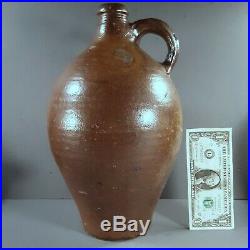
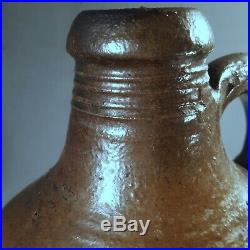
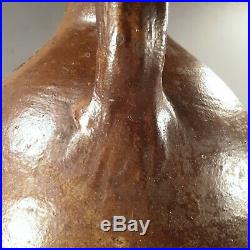


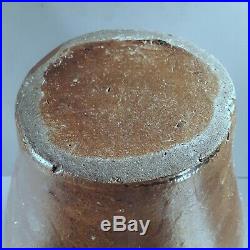
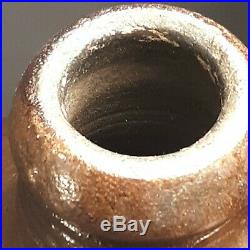
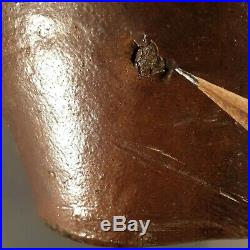

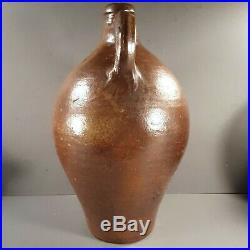



Antique Colonial British American Ocher Glazed Stoneware Large Ovoid Jug with Reeded or Ringed Neck (13.5 inches tall) and dating from the c1770 to c1810 period, hence the c1790 mid date (continue reading below; see also first 11 photos for jug features). Antique salt glazed stoneware large ovoid jug or bottle coated with ferruginous reddish brown ocher wash and exhibiting a multi-ringed or reeded neck (see first 11 Photos for jug offered here). The jug also displays exterior residual throwing ring ridges or rilling on its main the body (Photo 5) that were not fully removed by wiping. This jug dates from the late 1700s or very first decade of the early 1800s ca. 1770 to 1810 which yields the c1790 mid-date noted in the title. This jug represents an important transitional colonial American jug whose shape and characteristics blend together certain British and late colonial American potting styles suggestive of early New York City, New Jersey, Boston or lesser known factories of this time period. Finely reeded necks on stoneware jugs and bottles appear on some of the earliest stoneware produced in colonial America since these same neck details were also present on some stoneware vessels produced in Great Britain, particularly the brown stoneware jugs produced at Fulham, Lambeth and Derbyshire. Only the jug shown in the first 11 Photos is for sale in this listing (the other three Bellarmine style jugs shown in the last Photo, Photo 12, are for comparison only and are not for sale here at this time). The last Photo, Photo 12 shows the jug listed here next to three other jugs for making comparisons. These three other jugs help show certain attributed useful for this listing. The jug for sale here is on the viewers far left and next to it is a c1710 German or Frechen devolved bellarmine with a impressed design on its neck consisting of a bearded #2 topped with a crown that from a few feet away looks like stylized bellarmine face. This stylized face motif seems to be an innovative early adaptation of a stamped capacity number. The third jug on the right is a late standard Bellarmine from about 1690 with a poorly applied Bellarmine face and no lower body seal or medallion. The fourth and last stoneware jug appearing on the viewers far right in Photo 12 is a classic mottled tigerware saltglazed bellarmine bottle or jug from the 1650 to 1670 period with a applied stylized face and a mid-body medallion or seal of meaningless symbols. And as noted above, the only jug for sale here is the tallest jug seen standing on the viewers far left side of Photo 12 and which is considered to be of colonial American origin in lieu of any verifiable provenance. Other attributes of notable interest on the jug listed for sale here include a nicely formed slopping rounded pouring lip (Photo 2), the four well formed ridge rings just below the pouring lip (Photo 2), a cordoned or centrally grooved thick handle (Photo 4) attached at the lower neck and upper shoulder joint whereas the handles lower terminal is drawn out and flattened into the upper body of the jug (Photo 3, 11), a modest concave upward base such that the jug sits on its outer perimeter edge (Photo 6), and systematic and regular exterior rilling (Photo 5) indicative of a master potter who raised up his pots evenly despite the fact that this vessel had to be thrown in two sections and then luted and joined together. Rilling, as noted earlier is the faint ridges left by the potters fingers on the surfaces of a freshly thrown vessel. Typically, a potter will remove the rilling on the exterior of the vessel by wiping its surface with a damp cloth or sponge leaving only ridges or rilling on the interior of the pot. But for certain periods in history, exterior rilling was either left intact or even intentionally exaggerated as a kind of popular style or fashion e. See Cistercian ware of the 17th century, 18th century Buckley ware, or Jacoba jugs from Siegburg in the 14th and 15th centuries as discussed in Ekkart Klinges German Stoneware published in 1996: pages 28 -29. The shape of this tall ovoid jug is important and datable to the late 1700s on up to early 1800s especially when handle shape and rim-neck attributes are also included. This jug has a pronounced ovoid body form that exhibits its widest belly diameter much closer to the jugs shoulder-neck intersection than any of the other ovoid jug examples shown in Photo 12. The belly on an ovoid jug is the location where its maximum horizontal diameter occurs and can be seen to migrate upward toward the neck in one class of ovoid forms during the second half of the 1700s. In summary, a high bellied ovoid body form on a narrow base tends to occur in some colonial American stoneware jugs of the late 1700s on up to about 1810, and then continuing thereafter in much lower frequencies until about 1850. Cylindrical jugs replaced weakly ovoid jugs in the United States by about 1870. A colonial American affiliation for this jug is further supported by the absence of an interior slip or glaze as visible inside the neck (see Photo 7, lower down inside is hard to see but contains blackening from former contents), minor paring of the base as noted earlier, the pouring lip shape, a grainy gray clay body unlike European stonewares and the presence of stones in the matrix indicative of poor clay preparation more typical of colonial American wares (Photo 8 shows a 5/16 inch piece of gravel trapped in the clay). This jug is in very good condition as the Photos illustrate and especially given its large size and the fact that it is over 215 years old. Also, it has no major post-production damage, chips, hairlines or repairs (see all Photos). And the only manufacturing flaws this jug has are both minor and help verify its age, authenticity and method of production. The jug has three kiln stacking body scars and a couple more contact marks where the jug was touching other vessels in the kiln at the time it was fired. There are two visible contact scars on its ovoid body in Photos 1 and 9, and three smaller contact scars (two on the handle, and one smaller scar on the upper shoulder, see Photo 4). However, none of these contact scars create major indentations or deform the body as sometimes seen on jugs, bottles and bellarmines. This jug stands about 13 3/8 inches tall and has a maximum belly diameter of about 8 1/4 inches across at its widest part. The jug sits on a slightly concave upward base that has a diameter of about 4 1/4 inches. The pouring rim has an interior opening of about 1 inch and a maximum collar diameter of 1 7/8 inches. It is a wonderful early American antique salt glazed stoneware jug from the eastern or northeastern US in great shape, and so do make sure you seriously consider it while it is still available. PLEASE KINDLY TAKE A MOMENT & LOOK AT MY OTHER LISTINGS (some soon to be posted, too) for more uncommon 18th & 19th Century ITEMS of INTEREST – – Thanks for visiting and good luck on finding that special item or gift. As for us, kindly review our feedback for hundreds of satisfied buyers over our past two decades of service. Importantly, Docm113 has not had a single item damaged due to our packing negligence and we also have not had any packages lost or not delivered. This stoneware jug will not be immediately listed again since we do not participate in eBays automatic relisting program. THANKS for visiting and we wish you success in finding that very special item or gift that you are currently seeking. The item “C1790 Colonial American Ocher Glaze Stoneware Ring Neck Ovoid Jug 13+ inch tall” is in sale since Saturday, June 20, 2020. This item is in the category “Antiques\Primitives”. The seller is “docm113″ and is located in Frisco, Texas. This item can be shipped to United States.
- Category: Antiques
- Region of Origin: Northeastern US to Mid-Atlantic
- Size Type/Largest Dimension: 13 1/2 inches tall
- Style: Americana
- Material: Ceramic & Porcelain
- Original/Reproduction: Original
- Date of Creation: Pre-1800
- Type: Stoneware
- Color: Brown
- Signed: Unsigned

Posted in c1790
Tagged: american | c1790 | colonial | glaze | inch | neck | ocher | ovoid | ring | stoneware | tall